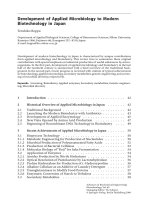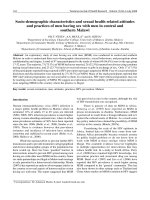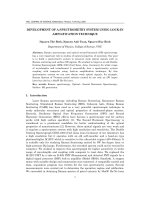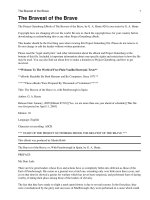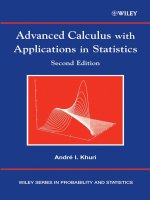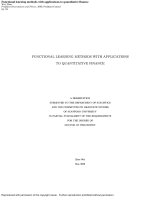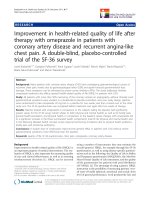Development of strong form methods with applications in computational mechanics
Bạn đang xem bản rút gọn của tài liệu. Xem và tải ngay bản đầy đủ của tài liệu tại đây (3.48 MB, 267 trang )
Founded 1905
DEVELOPMENT OF STRONG FORM METHODS WITH
APPLICATIONS IN COMPUTATIONAL MECHANICS
ZHANG JIAN
(M. Eng., National University of Singapore, Singapore)
(B. Eng., Dalian University of Technology, P. R. China)
A THESIS SUBMITTED
FOR THE DEGREE OF DOCTOR OF PHILOSOPHY
DEPARTMENT OF MECHANICAL ENGINEERING
NATIONAL UNIVERSITY OF SINGAPORE
2008
Acknowledgements
I would like to express my sincerest gratitude and appreciation to my supervisors,
Professor Liu Gui-Rong, Professor Lam Khin Yong and Assistant Professor Li Hua.
Professor Liu’s sharp thinking has always saved me from going into wrong directions.
I would like to thank him for his dedicated support, invaluable guidance and
continuous encouragement throughout the duration of this thesis. His influence on me
is far beyond this thesis and will benefit me in my whole life. Also, I would like to
thank Professor Lam and Assistant Professor Li for their sage advice, great patience
and support in the entire candidature. Their dedication to research and vast knowledge
inspire me in my future work.
Many thanks are conveyed to my fellow colleagues and friends, Dr. Kee Buck
Tong, Bernard, Mr. Xu Xiangguo, George, Dr. Zhang Guiyong, Dr. Deng Bin, Mr.
Song Chengxiang, Mr. Zhou Chengen, Dr. Dai Keyang, Dr. Zhao Xin, Dr. Gu
Yuantong, Dr. Wu Tianyun, Dr. Huynh Dinh Bao Phuong, Mr. Nguyen Thoi Trung, Mr.
Khin Zaw, Mr. Li Zirui and Dr. Cheng Yuan. The constructive suggestions, helpful
discussions and valuable perspectives among our group definitely help to improve the
quality of my research work. Most importantly, these guys have made my life during
my Ph.D. candidature a more meaningful one.
To my family, I appreciate their warm care and strong support. Especially to my
beloved wife, Ms. Sun Guoyuan, without her endless encouragement, support and
understanding, and sacrifice of all her time to take care of me, it is impossible for me
i
to finish this thesis. This piece of work is also a present for our daughter, Zhang
Mingjia Elysia, who was born on 26 January 2008.
Last not the least, I am very grateful to the National University of Singapore for
granting me the Research Scholarship and other support throughout my Ph.D.
candidature. Many thanks are also conveyed to Centre for Advanced Computations in
Engineering Science (ACES) and Department of Mechanical Engineering for their
material support to every aspect of this work.
ii
Table of Contents
Acknowledgements ....................................................................................................... i
Table of Contents ....................................................................................................... iii
Summary ...................................................................................................................... ix
Nomenclature ........................................................................................................... xiii
List of Figures ............................................................................................................ xvi
List of Tables............................................................................................................. xxv
Chapter 1 Introduction ................................................................................................ 1
1.1 Background .......................................................................................................... 1
1.2 Literature Review ................................................................................................. 4
1.2.1 The classification of meshfree methods ........................................................ 5
1.2.2 Meshfree methods based on weak forms ...................................................... 6
1.2.3 Meshfree methods based on strong forms .................................................... 7
1.3 Objectives ........................................................................................................... 10
1.4 Organization of the Thesis .................................................................................. 14
Chapter 2 Radial Point Interpolation Based Finite Difference Method ............... 17
2.1 Introduction ........................................................................................................ 17
2.2 Function Approximation..................................................................................... 19
2.2.1 Smoothed particle hydrodynamics (SPH) approximation .......................... 19
2.2.2 Reproducing kernel particle method (RKPM) approximation.................... 20
2.2.3 Moving least squares (MLS) approximation .............................................. 20
iii
2.2.4 Partition of unity methods ........................................................................... 22
2.2.5 Polynomial point interpolation ................................................................... 22
2.2.6 Radial point interpolation ........................................................................... 27
2.3 Radial Point Collocation Method (RPCM) ........................................................ 35
2.3.1 Formulation ................................................................................................. 35
2.3.2 Issues in RPCM........................................................................................... 37
2.4 Radial Point Interpolation Based Finite Difference Method .............................. 39
2.5 Numerical Examples .......................................................................................... 42
2.5.1 Poisson’s equation ...................................................................................... 43
2.5.2 Internal pressurized hollow cylinder ........................................................... 45
2.5.3 Infinite plate with a circular hole ................................................................ 46
2.5.4 Bridge pier .................................................................................................. 47
2.5.5 Triangle dam of complicated shape ............................................................ 48
2.6 Parameter Study.................................................................................................. 49
2.6.1 Number of local supporting nodes .............................................................. 49
2.6.2 Relations between the numbers of grid points and field nodes .................. 50
2.7 Remarks .............................................................................................................. 51
Chapter 3 Gradient Smoothing Method: The Theoretical Formulation .............. 74
3.1 Introduction ........................................................................................................ 74
3.2 Gradient Smoothing Method (GSM) .................................................................. 75
3.2.1 Gradient smoothing ..................................................................................... 76
3.2.2 Smoothing domains .................................................................................... 78
iv
3.2.3 Discretization schemes................................................................................ 79
3.2.4 Formulae for derivative approximation ...................................................... 80
3.2.4.1 Two-point quadrature schemes .............................................................. 81
3.2.4.2 One-point quadrature schemes .............................................................. 83
3.2.4.3 Directional correction ............................................................................ 84
3.3 Analyses of Discretization Stencil ...................................................................... 85
3.3.1 Basic principles for stencil assessment ....................................................... 86
3.3.2 Stencils for approximated gradients............................................................ 87
3.3.2.1 Uniform Cartesian mesh ........................................................................ 87
3.3.2.2 Equilateral triangular mesh ................................................................... 88
3.3.3 Stencils for approximated Laplace operator ............................................... 88
3.3.3.1 Uniform Cartesian mesh ........................................................................ 88
3.3.3.2 Equilateral triangular mesh ................................................................... 89
3.3.4 Truncation errors ......................................................................................... 90
3.4 Application and Validation of GSM ................................................................... 90
3.4.1 The governing equations ............................................................................. 91
3.4.2 Evaluation of numerical errors.................................................................... 93
3.4.3 Types of mesh ............................................................................................. 94
3.4.4 The role of directional correction ............................................................... 94
3.4.5 Comparison among four favorable schemes ............................................... 94
3.4.6 Robustness to irregularity of meshes .......................................................... 97
3.5 Remarks .............................................................................................................. 98
v
Chapter 4 A Gradient Smoothing Method for Solid Mechanics Problems......... 113
4.1 Introduction ...................................................................................................... 113
4.2 Convergence Study of the GSM ....................................................................... 114
4.3 Numerical Examples ........................................................................................ 116
4.3.1 Cantilever beam ........................................................................................ 116
4.3.2 Infinite plate with a circular hole .............................................................. 118
4.3.3 Bridge pier ................................................................................................ 119
4.3.4 An automotive part: connecting rod ......................................................... 120
4.4 Remarks ............................................................................................................ 121
Chapter 5 Adaptive Analyses for Solids using the GSM ...................................... 138
5.1 Introduction ...................................................................................................... 138
5.2 Adaptive Strategy ............................................................................................. 141
5.2.1 Error indicator ........................................................................................... 141
5.2.2 Refinement procedure and stopping criterion ........................................... 142
5.3 Numerical Examples ........................................................................................ 143
5.3.1 Patch test ................................................................................................... 143
5.3.2 Poisson’s equation with a sharp peak ....................................................... 144
5.3.3 Infinite plate with a circular hole .............................................................. 147
5.3.4 Short cantilever plate ................................................................................ 148
5.3.5 L -shaped plate ........................................................................................ 151
5.3.6 Mode-I crack problem............................................................................... 152
5.3.7 Singular loading problem .......................................................................... 154
vi
5.4 Remarks ............................................................................................................ 155
Chapter 6 Vibration Analyses of 2-D Solids using the GSM ................................ 185
6.1 Introduction ...................................................................................................... 185
6.2 The Governing Equations of 2-D Elastodynamics ........................................... 185
6.3 Free Vibration Analysis .................................................................................... 186
6.3.1 Strong form formulation ........................................................................... 186
6.3.2 Numerical results ...................................................................................... 188
6.3.2.1 A cantilever beam ................................................................................ 188
6.3.2.2 A variable cross-section beam ............................................................. 189
6.3.2.3 A shear wall ......................................................................................... 189
6.4 Forced Vibration Analysis ................................................................................ 189
6.4.1 Direct analysis of forced vibration ............................................................ 190
6.4.2 Numerical results ...................................................................................... 192
6.5 Remarks ............................................................................................................ 193
Chapter 7 Linearly Weighted Gradient Smoothing Method: An Introduction..202
7.1 Introduction ...................................................................................................... 202
7.2 Linearly Weighted Gradient Smoothing Method (LWGSM) ........................... 202
7.2.1 Gradient smoothing functions ................................................................... 203
7.2.2 Determination of coefficients ................................................................... 204
7.2.3 Approximation of spatial derivatives ........................................................ 206
7.2.3.1 Approximation of 1st-order derivatives (gradients) ............................ 206
7.2.3.2 Approximation of 2nd-order derivatives (Laplace operator) .............. 207
vii
7.3 Relations between GSM and LWGSM............................................................. 208
7.3.1 The formulation ........................................................................................ 208
7.3.2 Treatment of boundary conditions ............................................................ 210
7.4 Numerical Tests ................................................................................................ 211
7.4.1 Full model ................................................................................................. 211
7.4.2 Half model ................................................................................................ 212
7.5 Remarks ............................................................................................................ 213
Chapter 8 Conclusions ............................................................................................. 220
8.1 Concluding Remarks ........................................................................................ 220
8.2 Recommendations for Future Research ........................................................... 223
References ................................................................................................................. 226
Publications Arising From Thesis ........................................................................... 239
viii
Summary
Meshfree methods have been actively studied and many techniques are developed
aiming to overcome some drawbacks in the conventional numerical methods, such as
the finite difference method (FDM) and the finite element method (FEM). Among the
meshfree methods, the strong form methods using local nodes possess good potential
to become popular alternative numerical methods and most attractive feature to
facilitate the implementation for adaptive analysis. This is because the concept of the
strong form methods is very simple, and its formulation procedure is straightforward.
Neither formulation procedure nor construction of shape function requires numerical
integration. However, the development of reliable strong form methods using local
nodes remains much challenging, mainly due to the stability issues. Currently, most of
the reliable strong form methods are still restricted for structured grids and regular
domains. The instability is a crucial issue that limits the applications of strong form
methods, especially in the adaptive analysis. The solution with strong form method is
usually not stable and hence often less accurate than solution using weak form method.
The primary objective of the present work is, therefore, to develop new strong form
methods that are stable, so that the features of strong form methods, such as simplicity,
stability and accuracy, can be realized for adaptive and dynamic analyses in various
problems of computational mechanics.
As the first part of this work, a novel radial point interpolation based finite
difference method (RFDM) is proposed, in which the radial point interpolation using
ix
local irregular nodes is used together with the conventional finite difference procedure
to achieve both the adaptivity to irregular domain and the stability in the solution that
is often encountered in the collocation methods. Several numerical examples are
presented to demonstrate the accuracy and stability of the RFDM for problems with
complex shapes and regular and extremely irregular nodes. Also, a numerical study on
the effects of the parameters for RFDM is conducted.
In the second part of this work, as the main achievement of this thesis, a gradient
smoothing method (GSM) is developed and applied systematically in computational
mechanics. The theoretical aspects of the gradient smoothing method are first
exploited with focus on the principle of gradient smoothing and its numerical
procedure to solve partial differential equations. Stencil analyses of different types of
discretization schemes for spatial partial differential terms are carried out from points
of views of both efficiency and accuracy. The compactness of stencil and positivity of
the coefficients of supporting nodes are concerned in the analyses. The gradient
smoothing method has been successfully explored in the following aspects:
•
GSM for static analyses of solid mechanics
The GSM is applied to static analyses of solid mechanics problems. The
gradient smoothing operations are utilized to develop the first- and
second-order derivative approximations by successively computing the
weights for a set of nodal points surrounding a node of interest. Using the
approximated derivatives, the strong form of governing system equations can
be simply collocated at each scattered node in the problem domain. The
x
computational accuracy, efficiency and stability of the present method with
regular and irregular nodes are demonstrated through extensive numerical
examples. In comparison with other well-established numerical approaches
such as the finite element method (FEM), the proposed GSM produces
encouraging results.
•
GSM for adaptive analyses of computational mechanics
The GSM is further developed for the adaptive analyses. It can effectively
overcome the instability issue while retaining the strong form feature of
simplicity in formulation procedures which is particularly suitable for adaptive
analysis. In this thesis, a posteriori error indicator based on residual of the
governing equation is adopted. By evaluating the residual of the governing
equation for each triangular cell in the problem domain, error indicator
effectively identifies the necessary regions to be refined. Simple refinement
procedure using Delaunay diagram is adopted in the adaptive process.
Compared with the well-known finite element method, the GSM for adaptive
procedure demonstrates good reliability and performs well in several solid
mechanics problems including singularities and concentrated loading.
•
GSM for dynamic analyses of solids and structures
The free and forced vibrations analyses of two-dimensional solids and
structures are also conducted using the GSM. The governing equations of
elastodynamics are discretized with the strong form of GSM. The validity,
accuracy and stability of the present GSM for dynamic analyses are well
xi
demonstrated through intensive numerical investigations.
•
Linearly weighted gradient smoothing method --- a further step from the GSM
Moving beyond the GSM, a linearly weighted gradient smoothing method
(LWGSM) has been devised with piecewise linear smoothing functions for
gradient smoothing operation. The relations between GSM and LWGSM are
derived theoretically and numerically. It is very interesting to find that
LWGSM and GSM (Scheme VIII) have resulted in the identical solutions.
Some numerical tests are conducted to show the properties of different
schemes within the LWGSM.
xii
Nomenclature
a
Coefficient vector
A
Area of the domain
b
Body force vector
c
Damping coefficient
C
Damping matrix
dc
Characteristic length (average nodal spacing)
ee
Error norm in energy
eu
Error norm for variable u
e∂u ∂x
Error norm for derivative ∂u ∂x
E
Young’s modulus
f ,F
Force vector
G
Shear modulus
I
Moment of inertia of section
K
Stiffness matrix
L(), B()
Differential operator
m
Mass density
M
Mass matrix
n
Unit outward normal vector
n
Number of nodes in a local support domain
P
Loading
xiii
p(x )
Polynomial basis function
Pm
Polynomial moment matrix
q
Parameter of MQ radial basis function
q
Eigenvector
r
Distance
R (x )
Radial basis function
RQ
Moment matrix of radial basis function
t
Specified traction vector
U
Displacement vector
Us
Displacement vector of local support domain
u
Field variable
uc
Field variable at the centoid of a triangular cell
um
Field variable at the midpoint of a mesh-edge
uh
Approximation of field function u
u
Specified displacement vector
)
w
Weight function
x , y ,x
Spatial coordinates
αc
Parameter of MQ radial basis function
δ
Kronecker delta function
∇
Divergence operator
ΔS x , ΔS y
Length component of a domain edge
Δt
Time step
xiv
ε
Strain tensor
ε con
Convergence error index
ηg
Estimated global residual norm
ηj
Estimated local residual norm
η mg
Maximum value of η g throughout the adaptation
κg
Tolerant coefficient of the estimated global residual norm
κl
Local refinement coefficient
Γ
Problem boundary
Γt
Natural (Neumann) boundary
Γu
Essential (Dirichlet) boundary
γ
Mesh irregularity
Ο()
Truncation error
φi
Shape function component
Φ
Shape function vector
υ
Poisson’s ratio
θ
Rotation
σ
Stress tensor
ω
Frequency
Ω
Problem domain
Ωi
Smoothing domain for field node i
() ( L ) , () ( R )
Pointers to the left- and right-side domain faces with an edge
xv
List of Figures
Fig. 2.1 Pascal’s triangles of monomials for two-dimensional space .......................... 55
Fig. 2.2 Local support domains used in meshfree methods ......................................... 55
Fig. 2.3 A problem governed by PDEs in domain Ω . ................................................ 56
Fig. 2.4 Background grids for finite difference used in the RFDM ............................ 56
Fig. 2.5 100 regular field nodes ( • ) and 441 finite difference grid points ( × ) ........... 57
Fig. 2.6 Distribution of 121 extremely irregular nodes for Poisson’s equation........... 57
Fig. 2.7 Result along the line of x = 0.5 for Poisson’s equation ............................... 58
Fig. 2.8 Result along the line of y = 0.5 for Poisson’s equation .............................. 58
Fig. 2.9 Node distributions: (a) 50; (b) 100; (c) 200 and (d) 400 nodes...................... 59
Fig. 2.10 Error norms of solution for Poisson’s equation ............................................ 59
Fig. 2.11 Hollow cylinder subjected to internal pressure ............................................ 60
Fig. 2.12 Node distribution for the hollow cylinder .................................................... 60
Fig. 2.13 Radial displacement u r along the line of y = x in the hollow cylinder .. 61
Fig. 2.14 Circumferential stress σ θ along the line of y = x in the hollow cylinder
..................................................................................................................... 61
Fig. 2.15 Radial stress σ r along the line of y = x in the hollow cylinder ............. 62
Fig. 2.16 Node distributions in the hollow cylinder: (a) 200; (b) 400; (c) 800 nodes. 62
Fig. 2.17 Error norms of of radial displacement ur for hollow cylinder .................. 63
Fig. 2.18 Quarter model of the infinite plate with a circular hole subjected to a
unidirectional tensile load .......................................................................... 63
xvi
Fig. 2.19 Node distribution: 366 nodes ( • ) & 987 points (intersections of the dashed)
...................................................................................................................... 64
Fig. 2.20 Normal stress σ xx along the edge of x = 0 in the plate. .......................... 64
Fig. 2.21 A bridge subjected to a uniformly distributed pressure on the top. .............. 65
Fig. 2.22 Nodal distribution in the bridge model: 386 field nodes (dots) and 995 grid
points (intersections of dashed lines). .......................................................... 65
Fig. 2.23 Distribution of normal stress σ yy in the bridge: (a) RFDM; (b) ANSYS. . 66
Fig. 2.24 A triangle dam subjected to uniformly distributed pressure on the surface. 67
Fig. 2.25 Node distributions in the triangle dam: (a) 334 and (b) 4462 field nodes.... 68
Fig. 2.26 Displacements along the line of x = 8 : (a) x -direction; (b) y -direction. 69
Fig. 2.27 Normal stress σ yy distribution: (a) RFDM; (b) ANSYS; (c) Reference .... 70
Fig. 2.28 Distribution of a set of 100 randomly scattered nodes in a square domain.. 71
Fig. 2.29 Error norms of the field variable u computed by RFDM based on RBFs
using different numbers of local supporting nodes...................................... 71
Fig. 2.30 CPU time required by RFDM based on RBFs using different numbers of
local supporting nodes ................................................................................ 72
Fig. 2.31 Condition numbers of the coefficient matrix of the RFDM based on RBFs
using different numbers of local supporting nodes ..................................... 72
Fig. 2.32 Optimal grid points for Poisson’s equation .................................................. 73
Fig. 2.33 Optimal grid points for internal pressurized hollow cylinder ...................... 73
Fig. 3.1 Illustration of triangle cells and gradient smoothing domains defined in GSM
...................................................................................................................... 104
xvii
Fig. 3.2 Stencils for approximated gradients (
∂u i ∂u i
,
) on uniform Cartesian mesh
∂x ∂y
..................................................................................................................... 104
Fig. 3.3 The stencil for approximated gradients (
∂u i ∂u i
,
) on equilateral triangular
∂x ∂y
mesh (Identical for I, II, III, IV, V, VI, VII and VIII). ................................. 105
Fig. 3.4 Stencils for the approximated Laplace operator (
∂ 2 ui ∂ 2ui
+ 2 ) on uniform
∂x 2
∂y
Cartesian mesh. ........................................................................................... 105
∂ 2 ui ∂ 2ui
Fig. 3.5 Stencils for a Laplace operator ( 2 + 2 ) discretized onto equilateral
∂x
∂y
triangles. ...................................................................................................... 106
Fig. 3.6 Contour plots of exact solutions to the two Poisson’s problems .................. 106
Fig. 3.7 Profile plot of convergence history .............................................................. 107
Fig. 3.8 Representative meshes under investigation.................................................. 107
Fig. 3.9 Contours of relative errors on Cartesian mesh in the first Poisson’s problem
..................................................................................................................... 108
Fig. 3.10 Profiles of computational accuracy based on uniform Cartesian mesh...... 108
Fig. 3.11 Profiles of computational accuracy based on right triangular mesh ........... 109
Fig. 3.12 Profile of computational accuracy based on regular triangular mesh ........ 110
Fig. 3.13 Triangular meshes with various irregularity............................................... 111
Fig. 3.14 Overlapped cells in the computational domain ( γ = 0.16). ........................ 111
Fig. 3.15 Contours of solutions to Poisson’s equations discretized onto irregular
meshes. ..................................................................................................... 112
xviii
Fig. 3.16 Numerical errors in the GSM solutions (Scheme II and VII) to the second
Poisson problem with respect to irregularity of meshes ............................ 112
Fig. 4.1 Node distribution of Poisson’s equation: (a) 50; (b) 200; (c) 882 and (d) 3528
elements........................................................................................................ 124
Fig. 4.2 Comparison of convergence rate and accuracy between GSM and FEM for
Poisson’s equation with regular nodes: (a) eu and (b) e∂u / ∂x ................... 125
Fig. 4.3 Irregular nodes of Poisson’s equation: (a) 58; (b) 222; (c) 894 and (d) 3632
elements ....................................................................................................... 126
Fig. 4.4 Comparison of convergence rate and accuracy between GSM and FEM for
Poisson’s equation with irregular nodes: (a) eu and (b) e∂u / ∂x ................ 127
Fig. 4.5 Cantilever beam subjected to a parabolic load at the free end ..................... 128
Fig. 4.6 Domain discretization of cantilever beam: (a) nodes and (b) elements ....... 128
Fig. 4.7 Deflection of cantilever beam along the line y = 0 computed using the
same mesh (480 triangular elements) for GSM and FEM ........................... 129
Fig. 4.8 Normal stress σ xx along the line x = L / 2 computed using GSM and FEM
...................................................................................................................... 129
Fig. 4.9 Shear stress τ xy along the line x = L / 2 computed using GSM and FEM
..................................................................................................................... 130
Fig. 4.10 Quarter model of the infinite plate with a circular hole subjected to a
unidirectional tensile load ........................................................................ 130
Fig. 4.11 Quarter model of the infinite plate: (a) nodes and (b) elements ................. 131
Fig. 4.12 Normal stress σ xx along the edge of x = 0 in a plate with a central hole
xix
subjected to a unidirectional tensile load ................................................... 131
Fig. 4.13 A bridge pier subjected to a uniformly distributed pressure on the top ..... 132
Fig. 4.14 Half model of the bridge pier: (a) nodes and (b) element .......................... 132
Fig. 4.15 Displacement in y -direction along the line x = 0 ................................... 133
Fig. 4.16 Displacement in y -direction along the line y = 30 ................................ 133
Fig. 4.17 Displacement in y -direction along the line y = 15 ................................. 134
Fig. 4.18 Normal stress σ yy along the line y = 15 ................................................ 134
Fig. 4.19 An automotive part: the connecting rod ..................................................... 135
Fig. 4.20 Half model of the connecting rod: (a) node distribution and (b) element
distribution ................................................................................................ 136
Fig. 4.21 Displacement in x -direction along the line y = 0 ................................... 136
Fig. 4.22 Distribution of normal stresses along the line y = 0 : (a) σ xx and (b) σ yy
(GSM uses 2877 triangular elements while ANSYS adopts a very fine
triangular mesh to get the reference solution) ........................................... 137
Fig. 5.1 Residual evaluated at the center ( ) of a triangular cell. ............................. 160
Fig. 5.2 Illustration of the refinement procedure ....................................................... 160
Fig. 5.3 Patches of five nodes in the essential-patch-test .......................................... 161
Fig. 5.4 (a) Patches for the natural-patch-test: a uniform axial traction along the right
end of the patch; (b) Patch with 35 regular nodes; (c) Patch with 35 irregular
nodes ............................................................................................................ 162
Fig. 5.5 Three-dimensional plots of the exact solution to the Poisson’s equation with a
sharp peak: (a) u ; (b)
∂u
∂u
and (c)
. .................................................... 163
∂x
∂y
xx
Fig. 5.6 Node distributions of uniform refinement for Poisson’s equation with a sharp
peak at the center. ......................................................................................... 164
Fig. 5.7 Adaptive nodes from the 2nd to 5th step for solving Poisson’s equation .... 165
Fig. 5.8 Estimated global residual at each adaptive step for Poisson’s equation....... 165
Fig. 5.9 Comparison of error and convergence rate between uniform and adaptive
refinements for solving Poisson’s equation with a sharp peak ................... 166
Fig. 5.10 Approximated values of field function u along the line y = 0.5 at the
first and fifth steps .................................................................................... 166
Fig. 5.11 The three-dimensional plots of adaptive GSM solutions for Poisson’s
equation with a sharp peak at the final adaptive step: (a) u ; (b)
∂u
; (c)
∂x
∂u
............................................................................................................ 167
∂y
Fig. 5.12 Quarter model of the infinite plate with a circular hole ............................. 168
Fig. 5.13 Nodes of uniform refinement for infinite plate: from 39 to 1513 nodes. ... 168
Fig. 5.14 Node distributions of adaptive refinement at the 3rd and 6th steps for the
quarter model of infinite plate with a circular hole ................................... 169
Fig. 5.15 Estimated global residual at each adaptive step for the infinite plate ........ 169
Fig. 5.16 Comparison of error norm of displacement u x between uniform and
adaptive refinements for infinite plate with a circular hole ..................... 170
Fig. 5.17 Normal stress σ xx along x = 0 at the 3rd and 6th steps ........................ 170
Fig. 5.18 A short cantilever plate subjected to a uniformly distributed pressure ...... 171
Fig. 5.19 Node distributions of ‘uniform’ refinement for short cantilever plate ....... 171
Fig. 5.20 Node distributions of adaptive refinement at the 3rd and 6th steps for short
xxi
cantilever plate ........................................................................................... 172
Fig. 5.21 Estimated global residual at each adaptive step for short cantilever plate. 172
Fig. 5.22 Comparison of displacement u y (1,0) for short cantilever plate between
GSM and FEM with uniform and adaptive refinements .......................... 173
Fig. 5.23 Comparison of computed strain enegy for short cantilever plate between
GSM and FEM with uniform and adaptive refinements .......................... 173
Fig. 5.24 Comparison of error and convergence in energy norm for short cantilever
plate between GSM and FEM with uniform and adaptive refinements. ... 174
Fig. 5.25 Comparison of condition number of coefficient matrix for short cantilever
plate between GSM and FEM with uniform and adaptive refinements .... 174
Fig. 5.26 L -shaped plate subjected to a tensile load in the horizontal direction ..... 175
Fig. 5.27 Selected node distributions of uniform refinement for L -shaped plate.... 175
Fig. 5.28 Node distributions of adaptive refinement at the 3rd and 5th steps for
L -shaped plate ......................................................................................... 176
Fig. 5.29 Comparison of computed strain energy between uniform and adaptive
refinement for L -shaped plate................................................................ 176
Fig. 5.30 Comparison of error and convergence rate in energy norm between uniform
and adaptive refinements for L -shaped plate. .......................................... 177
Fig. 5.31 Mode-I crack problem: (a) geometry; (b) half model with boundary
conditions................................................................................................. 177
Fig. 5.32 Selected node distributions of uniform refinement for Mode-I crack ........ 178
Fig. 5.33 Node distributions of adaptive refinement at the 3rd, 5th, 7th and 9th steps
xxii
for Mode-I crack problem .......................................................................... 179
Fig. 5.34 Comparison of error in displacement in y -direction between uniform and
adaptive refinements for Mode-I crack problem ....................................... 180
Fig. 5.35 Comparison of strain energy between uniform and adaptive refinement... 180
Fig. 5.36 Comparison of error and convergence rate in energy norm between uniform
and adaptive refinements for Mode-I crack problem................................. 181
Fig. 5.37 A square solid subjected to a singular loading at the center of the top edge
................................................................................................................... 181
Fig. 5.38 Node distributions of uniform refinement for singular loading problem ... 182
Fig. 5.39 Node distributions of adaptive refinement at the 6th and 11th steps for
singular loading problem .......................................................................... 182
Fig. 5.40 Displacement u x ( x,5) between uniform and adaptive refinements......... 183
Fig. 5.41 Displacement u y ( x,5) between uniform and adaptive refinements........... 183
Fig. 5.42 Comparison of computed strain energy between uniform and adaptive
refinement for singular loading problem ................................................. 184
Fig. 6.1 A cantilever beam ......................................................................................... 197
Fig. 6.2 Nodal distribution of the beam: (a) 63 nodes and (b) 306 nodes ................. 197
Fig. 6.3 Eigenmodes for the cantilever beam obtained using the GSM .................... 198
Fig. 6.4 A cantilever beam with variable cross-sections (a) and its mesh (b) ........... 199
Fig. 6.5 A shear wall with four openings ................................................................... 200
Fig. 6.6 Displacement u y at the middle point of free end using different time steps
..................................................................................................................... 200
xxiii
Fig. 6.7 Transient displacement u y at the middle point of the free end of the beam
using the Newmark method ( δ = 0.5 and β = 0.25 ) ............................... 201
Fig. 7.1 Linearly weighted smoothing functions for different types of gradient
smoothing domains: mGSD, cGSD and nGSD ......................................... 218
Fig. 7.2 The schematic of a linearly weighted smoothing domain and its contained
sub-triangles ................................................................................................ 218
Fig. 7.3 Schematic of treatment of natural boundary conditions............................... 219
Fig. 7.4 The half model of a Poisson’s equation........................................................ 219
Fig. 7.5 Contour plots of relative errors using linear interpolation (LI) and gradient
smoothing (GS) in the LWGSM ................................................................. 219
xxiv
